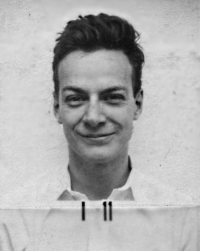Richard Feynman
Quantenphysiker
Basiswissen
Feynman lebte von 1918 bis 1988. Als junger Physiker wirkte er am amerikanischen Atombombenprojekt Ende des zweiten Weltkrieges mit. Feynman entwickelte das Konzept der Quantenpfade. Damit lassen sich Quantenphänomene wie das Doppelspaltexperiment halb-anschaulich erklären. Berühmt sind die Feynman-Lectures, eine in Buchform gefasste Zusammenfassung seiner berühmten Vorlesungen.
Empirist
Feynman war ein strenger Empirist. Das heißt, als letztendliches Wahrheitskriterium akzeptierte er nur Naturbeobachtung: "The principle of science, the definition, is almost the following: The test of all knowledge is experiment. Experiment is the sole judge of scientific 'truth'." Mehr dazu unter Empirismus ↗
Teilchendenker
"If, in somecataclysm, all of scientific knowledge were to be destroyed, and only one sentence passed on to the next generations of creatures, what statement would contain the most information in the fewest words? I believe it is the atomich hypothesis (or the atomic fact, or whatever you wish to call it) that all things are made of atoms - little particles that move around in perpetual motion, attracting each other when they are a little distance apart, but repelling upon being squeezed into one another. In that one sentence, you will see, there is an enormous amount of information about the world, if just a little imagination and thinking are applied." Mehr dazu unter Atomismus ↗
Buchtipp
Nebe den umfangreichen Feynman Lectures gibt es von Feynman geschriebene kleinere Bücher. In einem Buch erklärt er ganz ohne Mathematik die Theorie seiner Quantenpfade an alltäglichen Lichtphänomenen. Lies mehr über das Buch unter QED (Feynman) ↗
Fußnoten
- [1] Richard Feynman: Feymnan-Vorlesungen über Physik. Band 1. Mechanik, Strahlung, Wärme. Oldenbourg Verlag. 2007. ISBN:978-3-486-58108-9.
- [2] Richard Feynman: Feymnan-Vorlesungen über Physik. Band 2. Elektromagnetismus und Struktur der Materie. Oldenbourg Verlag. 2007. ISBN:978-3-486-58107-2.
- [3] Richard Feynman: Feymnan-Vorlesungen über Physik. Band 3. Quantenmechanik. Oldenbourg Verlag. 2007. ISBN:978-3-486-58109-6.
- [4] Richard Feynman: Eine Ergänzung der Feymnan-Vorlesungen über Physik. Tipps zur Physik. Oldenbourg Verlag. 2007. ISBN:978-3-486-58932-0. Siehe auch Feynman Lectures ↗
- [5] Richard Feynman: QED: Die seltsame Theorie des Lichts und der Materie. Piper Verlag. 1. Auflage 1992. ISBN: 3-492-21562-9. Siehe auch QED (Feynman) ↗
- [6] Richard P. Feynman: Kümmert Sie, was andere Leute denken?. Neue Abenteuer eines neugierigen Physikers. Gesammelt von Ralph Leighton. Mit 41 Abbildungen. Piper Verlag. München. 1991. ISBN: 3-492-03371-7. Titel der englischen Originalausgabe: What Do You Care What Other People Think (1988). Das Buch stellte autobiographische Selbstzeugnisse des Menschen Feynman zusammen. Unter anderem schildert er den Einfluss seiner Eltern auf sein Denken sowie - sehr ausführlich - seine unkonventionelle Arbeitsweise bei der Untersuchung der Ursachen der Explosion einer Raumfähre. Siehe dazu auch Space Shuttle ↗
